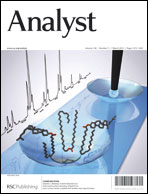The use of selectivity-enhanced Raman spectra of lube base oil (LBO) samples achieved by the spectral collection under frozen conditions at low temperatures was effective for improving accuracy for the determination of the kinematic viscosity at 40 °C (KV@40). A collection of Raman spectra from samples cooled around −160 °C provided the most accurate measurement of KV@40. Components of the LBO samples were mainly long-chain hydrocarbons with molecular structures that were deformable when these were frozen, and the different structural deformabilities of the components enhanced spectral selectivity among the samples. To study the structural variation of components according to the change of sample temperature from cryogenic to ambient condition, n-heptadecane and pristane (2,6,10,14-tetramethylpentadecane) were selected as representative components of LBO samples, and their temperature-induced spectral features as well as the corresponding spectral loadings were investigated. A two-dimensional (2D) correlation analysis was also employed to explain the origin for the improved accuracy. The asynchronous 2D correlation pattern was simplest at the optimal temperature, indicating the occurrence of distinct and selective spectral variations, which enabled the variation of KV@40 of LBO samples to be more accurately assessed.

You have access to this article
 Please wait while we load your content...
Something went wrong. Try again?
Please wait while we load your content...
Something went wrong. Try again?


 Please wait while we load your content...
Please wait while we load your content...